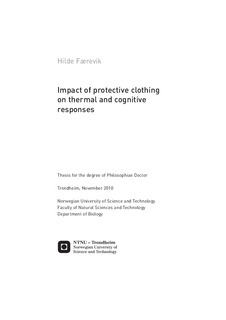| dc.contributor.author | Færevik, Hilde | nb_NO |
| dc.date.accessioned | 2014-12-19T13:11:40Z | |
| dc.date.available | 2014-12-19T13:11:40Z | |
| dc.date.created | 2011-01-21 | nb_NO |
| dc.date.issued | 2010 | nb_NO |
| dc.identifier | 390196 | nb_NO |
| dc.identifier.isbn | 978-82-471-2394-2 (printed ver.) | nb_NO |
| dc.identifier.isbn | 978-82-471-2395-9 (electronic ver.) | nb_NO |
| dc.identifier.uri | http://hdl.handle.net/11250/244709 | |
| dc.description.abstract | Current aircrew protective clothing is unable to the address the challenging situation that arises when the same clothing concept needs to provide sufficient thermal protection in water while also ensuring thermal comfort and optimal work performance during flights.
Performance, safety and health all suffer when environmental thermal stress factors exceed the body’s ability to compensate for disturbances in heat balance. Wearing protective clothing further increases the thermal stress, which increases the risk of human errors that can have fatal consequences.
This thesis addresses the fundamental mechanisms of how interactions among environmental temperature, clothing, work load, and physiological regulatory systems affect the working and emergency responses of helicopter pilots. The first part of this thesis investigated the impact of wearing protective clothing in a working situation on factors such as comfort, physiology and cognitive performance. The second part focuses on immersion in cold water, and in particular on the importance of improving heat balance during exposure to cold water.
This thesis has added to our knowledge of the ambient conditions required for thermal comfort and optimal performance in a working situation. In the emergency situation in cold water it also offers new knowledge about how to improve heat balance under extreme environmental conditions when wearing an immersion suit in cold waters.
The results of the studies described in this thesis have practical implications for the development of new types of protective clothing that will improve user safety without reducing comfort and work performance. | nb_NO |
| dc.language | eng | nb_NO |
| dc.publisher | Norges teknisk-naturvitenskapelige universitet, Fakultet for naturvitenskap og teknologi, Institutt for biologi | nb_NO |
| dc.relation.ispartofseries | Doktoravhandlinger ved NTNU, 1503-8181; 2010:206 | nb_NO |
| dc.relation.haspart | Færevik, H; Markussen, D; Oglaend, G E; Reinertsen, R E. The thermoneutral zone when wearing aircrew protective clothing. Journal of Thermal Biology. (ISSN 0306-4565). 26(4-5): 419-425, 2001. <a href='http://dx.doi.org/10.1016/S0306-4565(01)00054-7'>10.1016/S0306-4565(01)00054-7</a>. | nb_NO |
| dc.relation.haspart | Færevik, H; Reinertsen, RE. Effect of wearing aircrew protective clothing on physiological and cognitive responses under various ambient conditions. Ergonomics. (ISSN 0014-0139). 46(8): 780-799, 2003. <a href='http://dx.doi.org/10.1080/0014013031000085644'>10.1080/0014013031000085644</a>. | nb_NO |
| dc.relation.haspart | Færevik, H; Reinertsen, RE; Giesbrecht, GG. Leg exercise and core cooling in an insulated immersion suit under severe environmental conditions. Aviation, Space and Environmental Medicine. (ISSN 0095-6562). 81: 993-1001, 2010. <a href='http://dx.doi.org/10.3357/ASEM.2824.2010'>10.3357/ASEM.2824.2010</a>. | nb_NO |
| dc.title | Impact of protective clothingon thermal and cognitive responses | nb_NO |
| dc.type | Doctoral thesis | nb_NO |
| dc.contributor.department | Norges teknisk-naturvitenskapelige universitet, Fakultet for naturvitenskap og teknologi, Institutt for biologi | nb_NO |
| dc.description.degree | PhD i biologi | nb_NO |
| dc.description.degree | PhD in Biology | en_GB |

